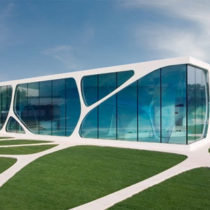Landscape Architecture for Landscape Architects › Forums › GENERAL DISCUSSION › North Arrow
- This topic has 1 reply, 7 voices, and was last updated 14 years, 8 months ago by
 Jon Quackenbush.
Jon Quackenbush.
-
AuthorPosts
-
April 11, 2011 at 6:58 pm #163688
 Zach WatsonParticipant
Zach WatsonParticipantSo I’m currently working with an electrical engineering firm and I noticed that they orient their plan drawings with their north arrow either to the top of the page (which is always preferable) or to the right.
At the last LA company that I used to work for we would orient the north arrow either to the top of the page or to the left.
I’m wondering what standards are in other offices for the direction the North Arrow points.
April 11, 2011 at 7:57 pm #163698 Jon QuackenbushParticipant
Jon QuackenbushParticipantdepends on how the view-port is set up ultimately. i don’t think it really matters where it is as long as it is viewable and consistent from drawing to drawing.
April 11, 2011 at 8:51 pm #163697 Trace OneParticipant
Trace OneParticipantnorth arrow must be UP! Unless it isn’t. (can’t fit drawing properly…). Then be consistent throughout the drawing set.
April 11, 2011 at 9:07 pm #163696 Andrew Garulay, RLAParticipant
Andrew Garulay, RLAParticipantAs said by others, North is generally upward, preferably straight up. I think that the convention that you are associating is that when a plan is “sideways” within a plan set, it should be oriented so that the bottom is to the right. The binding should either be to the left or on top so that you can turn the pages in a “normal” way like a book or on an easel. That would more often than not make the North arrow point to the left as you expect it.
There may be a very logical or practical reason that EEs do this, or they might not be following “normal” in that office. Maybe they use smaller paper and want to keep the arrow out of the fold of the binding? Ask them.
April 11, 2011 at 11:41 pm #163695 Zach WatsonParticipant
Zach WatsonParticipantSee I completely agree with you that when the site is ‘sideways’ on the paper the north arrow should be to the left, but we looked at several projects from other disciplines like civil engineers that they all oriented the north arrow to the right. Personally even ever possible I will always point the arrow to the left but I was just wondering what and if there was an industry standard.
April 12, 2011 at 12:06 am #163694 Andrew Garulay, RLAParticipant
Andrew Garulay, RLAParticipantI did a search on google. I found a city engineering standard that said “straight up”or “to the right” (small city in Washington State – I lived in that area and never heard of that city). I don’t think I’ve seen that as a standard in my area.
It is, as some others have said, how it best fits on the sheet with an effort to have North up.
April 12, 2011 at 12:21 am #163693 Claudia ChalfaParticipant
Claudia ChalfaParticipantI agree.
April 12, 2011 at 12:38 am #163692 Zach WatsonParticipant
Zach WatsonParticipantThanks I did a similar search online and found similar results, but I wanted to see what other people such as yourself thought and had practiced in the discipline. I think I will just go with the understanding that as long as everything is consistent then it doesn’t really matter.
April 12, 2011 at 12:49 am #163691 Andrew Garulay, RLAParticipant
Andrew Garulay, RLAParticipantI work on civil site plans way more than landscape plans and I also research and draw lots of recorded survey plans as well. I don’t recall seeing too many North arrows pointing right.
I’ve seen a lot of Massaachusetts Highway Plans with north arrows actually pointing toward the bottom of the page. They used long sheets of paper and ran the roads from one side to the other based on stationing rather than where North was.
April 12, 2011 at 5:51 am #163690 Thomas J. JohnsonParticipant
Thomas J. JohnsonParticipantI like Trace Ones answer. The North arrow is always up, unless it isn’t.
April 13, 2011 at 12:16 am #163689mark foster
ParticipantDepends on what the plan is for. If it is part of a larger database and to be used later to build on or mesh with others, then north arrow convention should definately be used.
If it is a document of it’s own and is intended for a specific site (and client need) only, then I agree with Jon–north doesn’t matter, and it’s view-port (niiiice phrase). I find prevailing wind and solstice sun arcs to be helpful. They help inform the light direction/quality at different times of day and year, microclimate temperature considerations, and plant choices.
-
AuthorPosts
- You must be logged in to reply to this topic.


